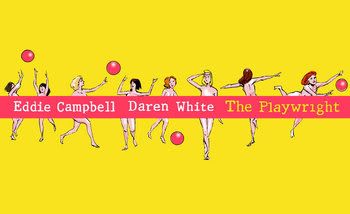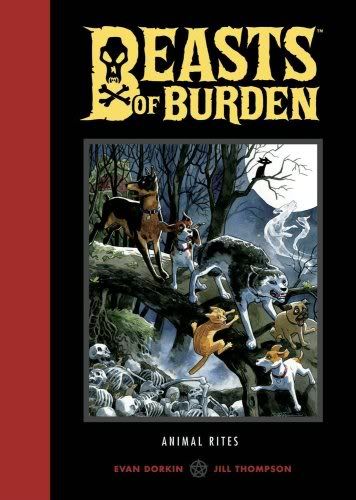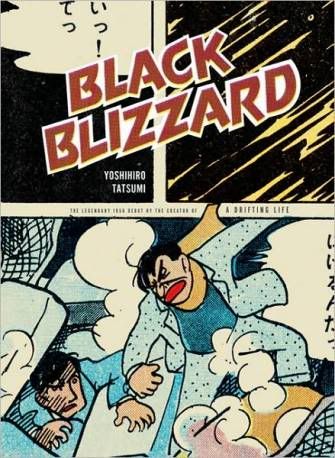
Tiger Tea by George Herriman
Krazy Kat wasn't strictly a "continuity strip"; i.e. , there wasn't an ongoing story that went on from day to day. The "Tiger Tea" sequence was one long exception to this rule. Krazy decides to help Mr. Meeyowl, the catnip dealer, after his business collapses. She goes on a mission to retrieve an extra-strong variety of catnip called Tiger Tea, that turns her, when she drinks it, from this sweet passive being into an aggressive, pugnacious, powerful figure. And, as they say, hijinks ensue. This is a really classic sequence. I first read it when it was reprinted in an issue of RAW. The new book suffers from being overdesigned, but well worth getting. A great introduction to this classic strip.

Other Lives by Peter Bagge
This new graphic novel by Peter Bagge really deserves a longer review than the few lines I am going to give it here. As far as I know, this is Bagge's first graphic novel that didn't appear serialized in comics first. But really, I think we can reasonably say that Bagge has been writing graphic novels for a long time. Hate was, in effect, two long graphic novels about one character, Buddy Bradley. His earlier narratives were by format and, I think, by authorial inclination very episodic. What kind of thrills me about Other Lives is how unepisodic it is. Everything happens fairly quickly, and the plot threads are so intertwined that it couldn't be split into chapters particularly easily. But the best thing about Other Lives is how deftly Bagge deals with a theme that is both extremely topical and ancient, that of constructed identity.
The Walking Dead, written by Robert Kirkman and drawn by Tony Moore
I thought I'd try this out since it has gotten a ton of good press, and now is going to be a TV series. I won't say it sucked, but I don't understand why people think it's so great. It seems similar, but not superior, to other "zombie" stories; The Walking Dead is, at best, a competently done pastiche. (Maybe subsequent volumes get better.)

Cartoon Workshop/Pig Tails by Paper Rad
I'll get my "hipster" union card revoked for saying this, but I thought this was boring and pretty bad. Visually, it did nothing for me. I've seen Paper Rad videos that were awesome, and Ben Jones' solo art is really cool. But this little color comic was a chore to read and not that great to look at.

The Playwright, written by Daren White and drawn by Eddie Campbell
Campbell doesn't usually collaborate with other writers, but this was a good pairing. Instead of an ordinary comic, there is a barebones written narrative that tracks Campbell's watercolors. It is a comic in the sense that both the drawings and text need each other, but it reads differently than what you might be used to. The narrative is full of nameless characters, identified by their profession. The main character is the Playwright. He comes across as completely self-absorbed and isolated, lacking any empathy. Yet his plays are highly successful. Over the course of the book, though, the Playwright opens up a bit. We start to see deeper into him. The Playwright reminded me, in some ways, of certain stories by English writers like Malcolm Bradbury, David Lodge and William Boyd, but it's hard to put my finger on how.

Red Snow by Susumu Katsumata
Publisher Drawn and Quarterly has embarked on a mission to publish important early manga in the U.S., particularly those classified as "gekiga" or dramatic manga. One can see the influence of Yoshiharu Tsuge here. The drawing is really good. But the stories didn't grab me as much as those by Yoshihiro Tatsumi. Still, they were pretty good and a refreshing alternative to most manga published in the U.S.

The Search for Smilin' Ed by Kim Deitch
So much of Kim Deitch's work hinges on demons (Waldo, the cat with a "1" on his belly is a minor sort) and aliens. But they also are intertwined with his real life, the real lives of various obscure showbiz figures, and the history of American popular culture. Do they fit together? Until reading this volume, I would have said no. But this story is one where Deitch tries to tie the various unruly strands of his many stories together. In a way, I almost prefer that these overlapping, nesting, and sometimes contradictory stories never really congeal, but The Search for Smilin' Ed is, like all of Deitch's work, a compelling and highly personal piece of work.

Beasts of Burden, written by Evan Dorkin and drawn by Jill Thompson
The idea of several dogs (and one cat) getting together to solve supernatural crimes is, well, pretty out there. It's not a concept that can sustain a lot of use. This book starts strong and gets harder to accept the further along you go. That said, there is a lot appealing here. Jill Thompson's art is fantastic and perfectly suited for this. The book is a pleasure to look at. My problem is, even though I was able to suspend my disbelief at first, it got harder and harder as it went along. But another problem is that the supernatural threats seemed very human. What might have worked better is if there were a world which only dogs could perceive that we humans were oblivious. And in fact, this is the case--a dog's sensorium is drastically different from a human's. That should have been played up more. The very first story in the book does this to an extent.
Catland Empire by Keith Jones
Great art, but the story seems just silly.

Black Blizzard by Yoshihiro Tatsumi
Only of historical interest. Tatsumi was one of the early "gekiga" artists, and this is one of the early gekiga stories. It dates from 1956, and the story is nothing special--a crime melodrama with a transparent "twist". But I guess stuff like this hadn't been seen in manga before. Apparently it broke ground. The art looks really rushed, and it was. The entire graphic novel (127 pages) was drawn in 20 days--no assistants. But as astonishing as that accomplishment is, it would be more meaningful if the book was any good.
More recently read comics are reviewed here.




No comments:
Post a Comment